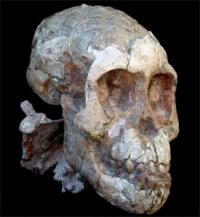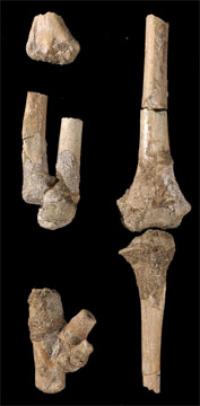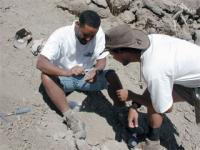
The skull of the Australopithecus afarensis child. 3.3 million years ago, a three year old girl died in present day Ethiopia, in an area called Dikika. Though a baby, she is providing us with unique accounts of our past as a grand mother would! Her completeness, antiquity, and age at death combined make this find unprecedented in the history of paleoanthropology and open many new research avenues to investigate into the infancy of early human ancestors. The extraordinary discovery reported this week in the scientific journal Nature, was found in north-eastern Ethiopia, by a paleoanthropological research team led by Zeresenay Alemseged of the Max Planck Institute in Leipzig, Germany.
The scientific significance of the new find is multifold, contributing substantially to our comprehension of the morphology, body plan, behavior, movement and developmental patterns of our early ancestors. After full cleaning and preparation of the fossil we will be able to reconstruct, for the first time, much of an entire body of a 3 year-old Australopithecus afarensis child, which will resolve many pending questions on early human evolution.
Some of the postcranial elements of the Dikika skeleton.
The new find represents a skeleton of the earliest and most complete juvenile human ancestor ever found that lived 150,000 years before Lucy. She was only three years old when she died and belongs to Australopithecus afarensis (the Lucy species) and was found in an area called Dikika, in Ethiopia, by a paleoanthropological team, the DRP (Dikika Research Project) led by Dr. Zeresenay Alesmeged of the Max Planck Institute. The DRP is an international and multidisciplinary project including several researchers with diverse areas of expertise, and about 40 assistants conducting field research in Ethiopia every year. The first piece of the baby was found on 10, December, 2000, but recovering the partial skeleton required intensive searching and sifting over four successive field seasons between 2000 and 2004.
Dr. Zeresenay Alemseged and geologist Dr. Jonathan Wynn discuss a newly discovered shin bone of the juvenile skeleton.
To date only recent Hominins such as Neandertals and modern humans are known by fairly complete skeletons of infants. For the preceding several million years of human evolution, however, not a single young child is know by remains representing more than a skull, a piece of jaw or some isolated teeth. By its completeness and state of preservation, the Dikika girl stands as one of the major discoveries in the history of Paleoanthropology. The find comprises the whole skull with a natural brain sandstone impression in addition to previously completely unknown or very little known skeletal parts including the hyoid bone. Of the upper part of the skeleton, most of the spinal column, both shoulder blades, the ribs and both collar bones were recovered. Shoulder blades, are almost absent in the fossil record of the earliest human ancestors save for fragmentary pieces from Lucy and another Australopithecus species (Australopithecus africanus). Parts of the lower limb, including both knee caps and substantial parts of the thigh and shinbone from both legs, were also recovered in addition to an almost complete foot. Contextual evidence from the sediments that yielded the baby, in addition to absence of evidence for carnivore activities, abrasion or corpse transport indicate that she was probably buried in a rapid flood event soon after death. It is also possible that the same flood could have caused her demise.
When discovered, all bones of the upper part of the skeleton including the skull, the shoulder blades, the collar bones, the ribs and the spinal column were encased in a very compact sandstone block and glued to each other. In most cases the difficulty paleoanthropologists face is putting very fragmentary pieces they find back together. In the case of the Dikika girl, however, the challenge was the opposite; sediments had to be removed almost grain by grain using dental instruments passing between ribs and the twisted spinal column. The process has taken the MPI researcher five years so far. The specimen was also CT scanned at the Diagnostic Center in Nairobi, Kenya. This technique enabled researchers to examine the developing permanent teeth allowing determination the sex, and age at death of the new fossil.
Among the major scientific contributions of this find are, first, the Dikika girl documents for the first time the complete skull morphology of juvenile Australopithecus afarensis. Based on the new find it is now possible to study how the skull of Australopithecus afarensis changed during growth when individuals passed from the childhood to adulthood. Second, the brain size of the Dikika girl, who was 3 when she died, is estimated at 330 cubic centimeters which is not very different from that of a 3 year-old chimpanzee. However, when compared to the adult values of its species, the Dikika baby had formed only between 63 and 88 % of the adult brain size, which is lower than that of chimpanzee where by the age of 3 over 90 % of the brain is formed. This relatively slow brain growth observed in Australopithecus afarensis is slightly closer to that of humans, pointing to possible behavioral shift in this species that lived 3.5 million years ago. Third, the postcranium (the skeleton other than the head) is represented by many bones that carry vital information regarding the locomotion (movement) and height of Australopithecus afarensis. The femur (thigh bone), the tibia (shinbone) and the foot of the girl preserve evidence that this ancient species walked upright effectively even at the age of three. However the two shoulder blades are similar to those of gorillas. The fingers are also long and curved as seen in other A. afarensis specimens. This raises old but unanswered questions. While an effective biped when on the ground, A. afarensis probably preserved its capacities for tree climbing which could have been adaptive for sleeping at night and avoiding predators, particularly for the little ones. Fourth, among the rare and exciting discoveries is the hyoid bone. Its morphology in the Dikika girl is similar to that of African great apes and different from that of humans. This bone is unknown for any extinct human ancestor species except for one Neanderthal specimen, and is presumed to have important role in human speech, giving us some clues to understand the nature and evolution of the human voice box. Finally, preparation of the new fossil is still in progress. Elements that are discussed here were investigated only partly. Also, it was not possible at this stage to examine many parts of the skeleton, particularly the ribs, the vertebrae and the collar bones and to analyze their relevance to the locomotor behavior of A. afarensis. When this is done in the future, however, a clear picture of the body plan of baby human ancestors will emerge and will be crucial for addressing questions pertaining to behavior, body proportions, height and skeletal development in early human ancestors.
Source : Max-Planck-Gesellschaft
 Print Article
Print Article Mail to a Friend
Mail to a Friend
